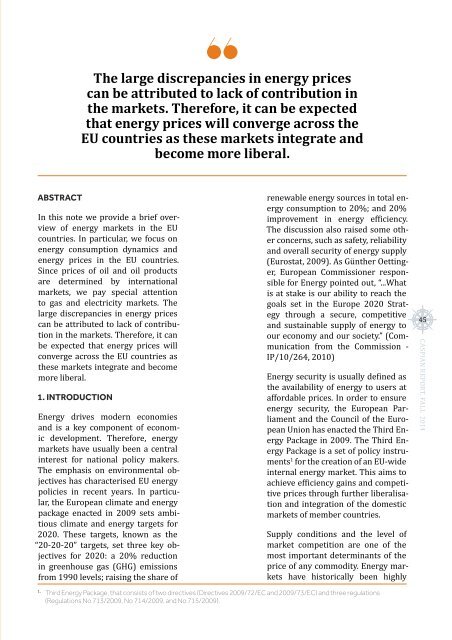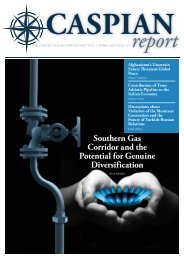You also want an ePaper? Increase the reach of your titles
YUMPU automatically turns print PDFs into web optimized ePapers that Google loves.
The large discrepancies in energy prices<br />
can be attributed to lack of contribution in<br />
the markets. Therefore, it can be expected<br />
that energy prices will converge across the<br />
EU countries as these markets integrate and<br />
become more liberal.<br />
ABSTRACT<br />
In this note we provide a brief overview<br />
of energy markets in the EU<br />
countries. In particular, we focus on<br />
energy consumption dynamics and<br />
energy prices in the EU countries.<br />
Since prices of oil and oil products<br />
are determined by international<br />
markets, we pay special attention<br />
to gas and electricity markets. The<br />
large discrepancies in energy prices<br />
can be attributed to lack of contribution<br />
in the markets. Therefore, it can<br />
be expected that energy prices will<br />
converge across the EU countries as<br />
these markets integrate and become<br />
more liberal.<br />
1. INTRODUCTION<br />
Energy drives modern economies<br />
and is a key component of economic<br />
development. Therefore, energy<br />
markets have usually been a central<br />
interest for national policy makers.<br />
The emphasis on environmental objectives<br />
has characterised EU energy<br />
policies in recent years. In particular,<br />
the European climate and energy<br />
package enacted in 2009 sets ambitious<br />
climate and energy targets for<br />
2020. These targets, known as the<br />
“20-20-20” targets, set three key objectives<br />
for 2020: a 20% reduction<br />
in greenhouse gas (GHG) emissions<br />
from 1990 levels; raising the share of<br />
renewable energy sources in total energy<br />
consumption to 20%; and 20%<br />
improvement in energy efficiency.<br />
The discussion also raised some other<br />
concerns, such as safety, reliability<br />
and overall security of energy supply<br />
(Eurostat, 2009). As Günther Oettinger,<br />
European Commissioner responsible<br />
for Energy pointed out, “...What<br />
is at stake is our ability to reach the<br />
goals set in the Europe 2020 Strategy<br />
through a secure, competitive<br />
and sustainable supply of energy to<br />
our economy and our society.” (Communication<br />
from the Commission -<br />
IP/10/264, 2010)<br />
Energy security is usually defined as<br />
the availability of energy to users at<br />
affordable prices. In order to ensure<br />
energy security, the European Parliament<br />
and the Council of the European<br />
Union has enacted the Third Energy<br />
Package in 2009. The Third Energy<br />
Package is a set of policy instruments<br />
1 for the creation of an EU-wide<br />
internal energy market. This aims to<br />
achieve efficiency gains and competitive<br />
prices through further liberalisation<br />
and integration of the domestic<br />
markets of member countries.<br />
Supply conditions and the level of<br />
market competition are one of the<br />
most important determinants of the<br />
price of any commodity. Energy markets<br />
have historically been highly<br />
45<br />
CASPIAN REPORT, FALL <strong>2014</strong><br />
1.<br />
Third Energy Package, that consists of two directives (Directives 2009/72/EC and 2009/73/EC) and three regulations<br />
(Regulations No 713/2009, No 714/2009, and No 715/2009).










